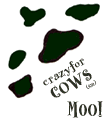|
Breed: Brahman:
- The Brahman breed was developed from Bos indicus cattle from India.
- Four types of Bos indicus were used: the Gir, Guzerat, Nellore, and Krankrej.
- Because Bos indicus are sacred in India, many Hindus will not sell them, eat their meat,
or allow them to be slaughtered.
- Because of this and quarantine regulations in the US, it is difficult to import Bos indicus
cattle into the US from India.
- The original Bos indicus cattle that entered the US did so by way of England in the mid
1800s.
- The cattle's adaptibility to life in the hot, humid Southern US was quickly recognized and
the Brahman breed was developed from these original Bos indicus cattle with some European
cattle (Bos taurus). Additional Bos indicus cattle were brought in to the US by way of
Brazil.
- Due to centuries of living in tropical India, with exposure to insect pests, parasites, diseases,
and heat, Bos indicus cattle developed adaptations for survival.
- They have more highly developed sweat glands and can perspire more freely than European cattle.
- They produce an oily secretion in their skin that may help repell insects.
- Bos indicus type cattle have several features that distinguish them from European cattle:
long, pendulous ears, a hump over the shoulder and neck area, and a large throatlatch and dewlap which
have a lot of excess skin.
- They have a long, concave face, and a slanty rump.
- The Brahman shows all of these Bos indicus characteristics.
- Brahman are also intelligent, inquisitive, and shy.
- They like affection and can become very docile if handled well.
- Brahman show little effect from temperatures up to and beyond 105 degrees Fahrenheit. Yet they
can tolerate cold temperatures well, too.
- Brahman are known for growing quickly, living a long time, and producing rich milk.
- Brahman come in different colors, including black, brown, white, grey, red, and spotted, although
solid grey and red are most common.
- Bulls are typically darker than cows.
- Bulls stand about 4 1/2 feet high at the withers, not including the hump, and weigh an average
of 2000 pounds.
- Cows stand about 4 feet high at the withers (again, not including the hump), and weigh an average
of 1200-1300 pounds.

Sources:
A Field Guide to Cows, by John Pukite, Falcon Press, Helena, Montana, 1996, pp. 104-105.
and
OSU's Breeds of Livestock
-- Brahman Cattle page.
|



